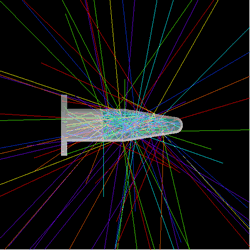By Calla Cofield

Image courtesy of Nicole Ackerman
Inside an Eppendorf tube, Cherenkov photons are released from the decay of fluorine 18 in water. The paths of the photons are reconstructed from data, and while the light is too faint for human eyes to see, the color of the photons in the image corresponds to their actual wavelength.
“I’m still simulating particles interacting with matter,” said Ackerman. “They are just in mice now instead of in a detector.”
At the 2011 APS April Meeting in Anaheim, California, Ackerman delivered a general session talk and spoke to reporters about her work.
One of the biggest goals of modern cancer research is to develop better imaging techniques. Imaging is key to early diagnosis, effective treatment, and finding cancer cells that have metastasized. Many medical imaging techniques rely on nuclear and particle physics principles, and yet, says Ackerman, many of the biologists working with those techniques don’t understand the physics behind them.
In positron emission tomography, or PET, positron-emitting radioactive isotopes are attached to molecules designed to bind to specific types of cancer cells. When the isotopes decay, they produce gamma rays that signal the presence and location of those cancer cells.
In 2009, scientists in Cambridge, Massachusetts published a proof of concept paper demonstrating that radioactive isotopes used in medical imaging will cause water-dense tissue to emit optical Cherenkov radiation. In materials the speed of light is lower than in a vacuum, and high energy particles may emit Cherenkov radiation when they travel faster than the photons. Radioisotopes have been used to treat cancer for over fifty years, and while some biologists and doctors had noted the optical glow before, no one, it seems, had thought to use it.
In a preclinical and research setting the technique offers some significant benefits over PET scans, including the fact that optical scans only take 3 minutes, where PET scans take 30, and optical scanners are less expensive and used more frequently by research staff.
In the future, Cherenkov light may offer imaging where there is currently none. There are presently no direct ways to image alpha and electron emitters in the body. Cherenkov radiation, however, can be used with positron, gamma, electron and alpha emitters, at short time intervals. Rather than delivering one dose of radioactive isotopes to image a tumor and a second to treat it, doctors could watch the treatment dose directly.
Because Cherenkov light is optical, it scatters quickly when traveling through tissue and would likely be used to image shallow tumors such as skin cancer or some breast cancers, or cancer of the esophagus, viewed via an endoscopy. A recent paper proposed using Cherenkov light immediately following tumor removal surgery, to see if any cancerous cells are left behind. Another group has proposed using a molecular component called a fluorophore that would lengthen the wavelength of the Cherenkov light at its source, and allow it to travel further through tissue to a detector.
Ackerman’s work is focused on modeling the path of the Cherenkov photons as they travel through tissue. She uses a software program called Geant4, which was designed to model particle tracks in high-energy physics experiments. She says she isn’t sure yet how exactly the models will be used, but she wants to understand the mechanisms behind the observations her group is making.
“I don’t mind thinking about cross sections and spectra and path length, but the biomedical researchers don’t want to,” said Ackerman. “My goal is to find the places where the physics details are important and then take the equations and simulations and turn them into something useful for the other researchers in the field.”
Early in her involvement with the oncology group, Ackerman was studying the Cherenkov radiation from actinium 235, one of the isotopes used by the group in tumor treatment because it releases an alpha particle. She realized that this alpha particle shouldn’t be fast enough to generate Cherenkov light in tissue, and yet, there was clearly an optical signal when they injected actinium 235 into mice. She deduced that daughter isotopes of the Actinium actually release a beta particle responsible for the Cherenkov light, and that this is the case for all the alpha-decay isotopes used by the group. Researchers could still use the Cherenkov light to monitor alpha particles used for treatment, but they would have to consider the time delay between the release of the alpha particle and the release of the beta particle, and a difference in the location of the parent isotope and the source of the radiation. Ackerman is currently investigating another isotope that causes Cherenkov radiation, even though it doesn’t appear to emit high enough energy particles to do so.
Ackerman says she never planned on switching to biological physics mostly because she had no idea what it entailed. While attending the Lindau Nobel Laureate conference in Germany last summer, she saw, for the first time, professional biology and chemistry lectures, and was fascinated by the range of applied physics topics presented there. Once she saw how her skills would be valuable in an area dominated by biologists, the decision to transition came easily.
Now Ackerman is putting her physics knowledge to work on various topics within the radiation oncology department. For her thesis project she will look at how radiation interacts with cells to kill them, while exploring ways to boost those interactions.
“I might not find a new particle or a new law of the universe, but that’s okay,” said Ackerman. “Instead I might be contributing to saving lives. I really feel like I can do some good here.”
©1995 - 2024, AMERICAN PHYSICAL SOCIETY
APS encourages the redistribution of the materials included in this newspaper provided that attribution to the source is noted and the materials are not truncated or changed.
Editor: Alan Chodos
June 2011 (Volume 20, Number 6)
Articles in this Issue

